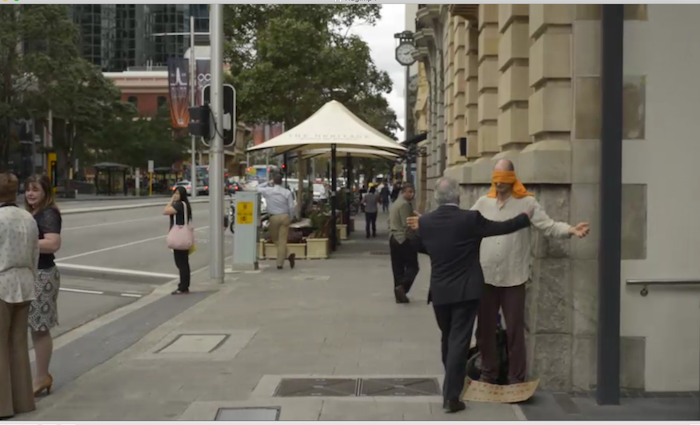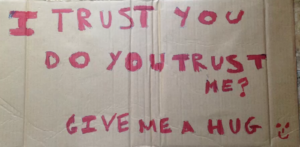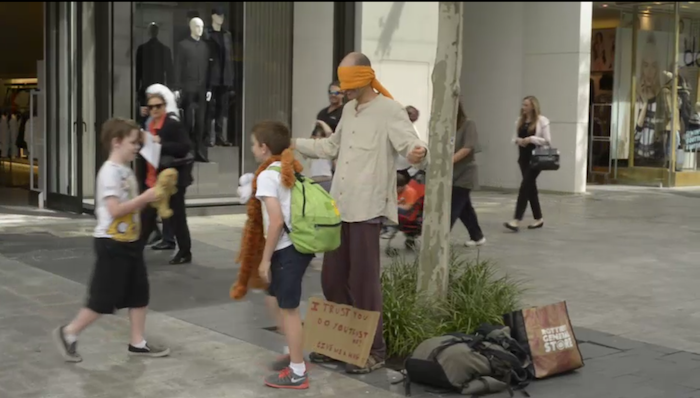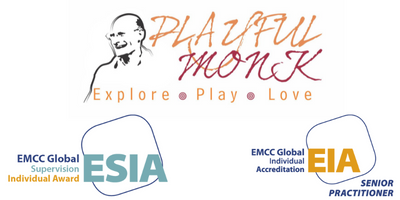In early April of 2020 I shared with my LinkedIn community a post about trust, it included a video of a social experiment undertaken when I stopped being a monk five years ago. The post received over 100 likes and 7000 views and I’m grateful and surprised at the interaction. If you have not seen the video and post go here and have a look!
One of my agile colleagues, Michael Short sent me an email about how agile the whole event was:-
So in terms of the four values of Agile – Michael broke it down as follows:-
individuals and interactions over processes and tools;
“If you had spent the time to understand what you should do, what laws and rules you needed to follow, this would probably have taken months. As this was individuals and interactions and was in a public space, there was no need for such planning, especially as you couldn’t see the individuals who were about to hug you and it was their free choice. The need for processes and tools was virtually zero, a blindfold and a sign.”
Working software over comprehensive documentation
“There was one piece of documentation, a cardboard sign. It just works, people don’t need to be told how to do something they do every day, they know what they want and why, the how, it’s just two people coming together.”
Customer collaboration over contract negotiation
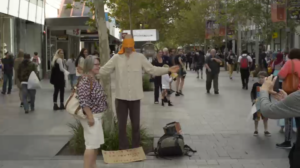 “The customer(s) came up and gave you a hug, there was not a long conversation. Interestingly, by being blindfolded, you gave the customer the control and they pulled their needs from the service you offered and you adapted as required.”
“The customer(s) came up and gave you a hug, there was not a long conversation. Interestingly, by being blindfolded, you gave the customer the control and they pulled their needs from the service you offered and you adapted as required.”
Responding to change over following a plan
“There was no need to write a plan and a long list of rules and requirements and conditions. It is very interesting to note that there were many different “hug requirements”, there was inspect and adapt. The hugger inspected what and how they wanted to hug you; shorter, taller, more than one person, men and women, adults and children, sometimes a short interval and sometimes longer, sometimes formal and sometimes intense. You then responded to their hug and provided the interaction the customer wanted, perfect.”
“This whole video perfectly illustrates the mindset and the key tenets of the values of agile and how you make these work in everyday life. Simple, customer first and value delivery.”
How do you develop an agile mindset and why is it important?
To trust in agile is to see the world through a lens of continuous change and asking what is really going on? To be with change requires you to be present with what is actually happening, not what you think is happening or what you hope or want to happen: it is to have clarity.
In my life as a Buddhist Monastic, I was continually challenged to see how things are, not how I would like them to be. The basic instruction was to notice the in-breath and the out-breath, this is something that continually changes. It was not to change the breath, make it hot, cold, or long or short, to make it better, to compare with somebody else – rather simple, isn’t it?
From this simple observances, you develop a strong focus where you can start to sense and observe complexity: the body sensations, the mental chit-chat. After practising this for a while you can refine the process to sense more of how the body responds, the thought process and the environment.
What happens is that the mind wanders and you get lost in your breakfast, your last wonderful holiday or the difficult conversation you just had: you fail. As a monastic, you learn to be kind to yourself, accept the failure, reflect on what went on and start again.
This is also the key to any agile transformation for the ability to start simple and be with complexity.
What I have noticed is that agile transformation gets stuck when it gets caught up in behaviours, beliefs and a reactive mindset of the people trying to implement it, they don’t see clearly what is happening. What can this lead to? Well, this leads to choosing the safest and least uncertain option and sticking with processes rather than individuals and interactions, which by their nature are messy and uncertain.
What has been interesting for me to see during the lockdown is that these set of conditions have allowed, on the whole, an outpouring of generosity. It seems to me that with little recourse to management, courses, gurus, or consultants, some people self-organised, found out what worked and got on with it.
Could it be that simple that we are built for trust and community?
In contrast for many, this has been a stressful time, you may have noticed the same stress can produce an alertness which can keep us present to what is actually going on, it is addictive, not calm, and leaves us tired. Stress can also send our thoughts in a spin and make our body unwell and that is why learning to deal with stress, in the first place, is so important. The agility mindset is key to being with stress as it allows you to respond rather than react and build on human connection, which is a powerful ally to deal with stress.
What you might have also noticed is that when you are focused and calm, the thinking process moves to the background and there is a fluidity in responding to what is happening. This is fundamentally different from following a process. As Micheal says there were no long manuals on how to do the hug, I used the agile principle of inspect and adapt, in my monastic training it was called contemplative reflection: of noticing what is happening now.
This a podcast with Ashwin Krishan who interviewed me about my inner experience of the hug – listen to the full episode here
How do you reflect on what is going on?
This ability to reflect on what is going on and not react is a must for C-suite executives, leaders, managers and those wanting a successful agile transformation. This reflective process approach is not one of overthinking, it is one of sense-making: to listen. The ability to pause, sense and respond, of course, it requires knowledge but not as much as you might think. To be able to attend to oneself and the situation requires a high degree of self-awareness and understanding of the thinking mind.
The PlayfulMonk approach is the way I help leaders, executives and organisation stay calm and connected in complex situations. It develops the creativity of a child and combined with the insight I got from being a Buddhist monastic. It is based on exploring what is going on, developing an attitude of playfulness to stay focused, and love to be courageous. This helps to you recognise presences which is the ability to be with any situation and helps your stay connected with yourself and others so you can have an impact.
